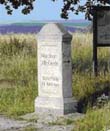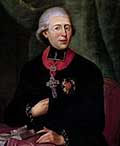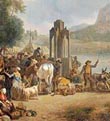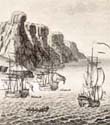| |
| |
EDITORIAL
As Chaucer noted more than 500 years ago, when the weather gets nice, people think about going pilgrimages. And this summer, what better pilgrimage site for the Napoleonic enthusiast than Jena and the German region of Thuringia. And even if you're not a dyed-in-the-wool military enthusiast, there are plenty of other things to enjoy. A glance at the extraordinary list of world famous figures who lived and worked in the nearby city of Weimar - Goethe, Schiller, Liszt, Strauss, Nietzsche, Kafka... - says it all. But even if you can't get there physically, the wonders of internet can take you there in spirit. Just take a walk though our web itinerary, made in collaboration with the Town of Jena.
Happy surfing.
Peter Hicks
Historian

|
|
|
| |
NAPOLEONIC ITINERARIES: DISCOVER JENA
Since 2006 is bicentenary year for the battle of Jena, why not visit this remarkable part of Germany. We bring you here an itinerary with three routes created by the Town of Jena. The first route takes you around the battlefield of Jena with its splendid setting in the valley of the river Saale, via the Napoleon stone and the museum in Cospeda. The second route takes you to the site of the battle of Auerstedt, and the third takes you along the Napoleon route with the different parts of the battlefield linked by foot, cycle or car routes. Here you can plant your footsteps in those of the Grande Armée. And going a little further a-field we bring you the jewels of region, including Weimar and Erfurt. Have a nice wander!
Dornberg © Stadtmuseum Jena

|
|
|
| |
SPECIAL DOSSIER: THE CREATION OF THE CONFEDERATION OF THE RHINE, 12 July, 1806
After having sketched out his ideas regarding France and German lands in a letter to Talleyrand (Minister of Foreign Affairs) dated October 1805, Napoleon went further in the spring of 1806, creating a confederation of small western German states grouped around the three "principal" allies, Bavaria, Wurtemberg and Baden. This (essentially defensive) bastion was later to serve as a springboard for offensive manoeuvres against Prussia, Austria and also Russia.
Dalberg, Prince Primat of the Confederation of the Rhine. (de.wikipedia.org)

|
|
|
| |
THIS MONTH'S PAINTING
Fair by a river, Jean-Louis Demarne
Of Flemish origin, Jean-Louis Demarne made his name as an illustrator of the rustic mores of his day, concentrating on the daily life of the working classes from the Revolution to the Empire period and rustic scenes. The presence of small gothic monuments in many of his pictures is indicative of the incipient Romantic style borrowed from troubadour painting. Demarne was hugely successful during the Empire period, both amongst aristocratic and middle classes.

|
|
|
| |
NAPOLEONIC PAGES
John R. Glover, secretary to Rear Admiral Cockburn (on board the "Northumberland"), with introd. and notes by J. Holland Rose, London, T. Fisher Unwin, 1906
This previously unpublished account of Napoleon's voyage to St Helena by a British eyewitness was published almost simultaneously in French and English in 1893. The author was John Richard Glover, secretary to George Cockburn, the British Admiral to whom Napoleon's safe conduct to St Helena had been entrusted.

|
|
|
| |
PhD VIVA
On Tuesday 27 June, 2006, Isabelle Rouge-Ducos, winner of a Fondation Napoléon research grant in 2003 and archivist at the French Defence ministry defended her art history thesis: "The Arc de Triomphe, the construction and appropriation of a national monument 1806-1945". The president of the jury was Jacques-Olivier Boudon, professor at Paris IV-Sorbonne and the jury included Annette Becker, professor at Paris X Nanterre, Sabine Frommel, Director of Studies at the Ecole pratique des hautes études, June Hargrove, professor at the University of Maryland, USA, and Jean-Michel Leniaud, director of studies at the Ecole pratique des hautes études, and Frédéric Chappey, lecturer at Lille III-Charles de Gaulle. At the end of her viva (which lasted four hours), Madame Rouge-Ducos was awarded the accolade "félicitations du jury" and the note "très honorable" (summa cum laude). The Fondation Napoléon sends its delighted congratulations.
200 YEARS AGO
On 4 July, 1806, an imperial decree was passed re-establishing the national stud farms or Haras, which had been suppressed during by the Assemblée constituante on 29 January, 1790. In the absence of national stud farms, horses were requisitioned from the countryside causing significant difficulties for farmers. Napoleon decided to re-establish France's national equine administration. Quality horse production was established in 6 national stud farms and thirty stallion depots, and the industry was given a grant of 2 million francs (including bonuses and horse race prizes), a total which was to drop to 200,000 F in the period 1810 to 1813.
And also:
Journal des Dames et des Modes, 5 July, 1806: «No more lined curtains at the window; on the boulevards and in the new neighbourhoods jalousies or shutters are all the rage. And to have them painted any colour but grey is social death!»
150 YEARS AGO
On 1 July, 1856, Napoleon III went to take the waters in Plombières-les-Bains, the spa town in the Vosges region, in an attempt to cure his rheumatism - he was 48 years old. He knew the town well since he had been there many times, not only with his grandmother, the empress Josephine but also with his mother, Queen Hortense. He lodged in a small 18th-century hotel, the Maison des Dames, in rue Stanislas. Arriving on 2 July, he did not leave until 8 August. He was later to return to Plombières several times, most notably in July 1858 for a secret meeting with Comte Cavour, head of the Italian government. Here they came to an agreement not only regarding an alliance against Austria but also concerning the reorganisation of Italy which was to lead to Italian independence and unification...
On 5 July, 1856, the senate met to discuss regulations regarding mineral waters and general conditions in spa establishments. The law was adopted on 14 July, 1856.
On 6 July, 1856, the Duchesse de Montebello, widow of Marshal Lannes, died in her town mansion in Rue de Varenne, Paris. The funeral took place on 8 July, 1856, the Eglise des Missions étrangères (Moniteur universel, 7 July, 1856).
Née Louise Guéhéneuc, daughter of a senator and financier, the duchess was Lannes's second wife. They were married on 16 September, 1800, and had five children. After Lannes' death at the battle of Essling 1809, Napoleon made her Duchesse de Montebello, and chief lady in waiting to the empress Marie Louise.
Wishing you an excellent, Napoleonic, week.
Peter Hicks
Historian and Web editor
THE NAPOLEON.ORG BULLETIN, No 378, 30 June to 6 July, 2006
Interested in the work of the Fondation Napoléon? Why not participate, either generally or in a specific project, by making a donation.
© this Napoleon.org weekly bulletin is published by the Fondation Napoléon. Reproduction or all or part of this bulletin is forbidden, without prior agreement of the Fondation Napoléon.

|
|
|
|
|
|
|
|
FONDATION NAPOLEON LIBRARY
During the summer, from 17 July to 18 August, the Bibliothèque M. Lapeyre-Fondation Napoléon library will have the following opening hours:
Tuesday, Wednesday and Thursday from 1-30 to 6pm. Normal opening times will resume on 21 August.
THIS WEEK in the MAGAZINE
Television:
The century that made us
Conferences:
Workshop: Luigi Emanuele Corvetto (1756-1821), financier, lawyer and politician, Genoa–Imperia, Italy
Commemorations:
- Pultusk 2006, Pultusk, Poland
- Jena 1806-2006 - Rendezvous in Thuringia The "Journées de Thuringe 2006" and the bicentenary of the Battle of Jena/Auerstädt
Exhibitions:
-Adel im Wandel (Changing nobility), Prinzenbau and Landeshaus, Sigmaringen, Germany
- Bayerns Krone 1806 (Bavaria's crown, 1806), Munich, Germany
- Napoleon and Nassau, Wiesbaden Casino-Gesellschaft, Germany
- Das Königreich Württemberg 1806–1918. Monarchie und Moderne (The kingdom of Württemberg 1806–1918. Monarchy and modernity), Stuttgart, Germany
- 200 Jahre Großherzogtum Baden (200 years of the Grand Duchy of Baden), Karlsruhe, Germany
- The price of the new crown: Baden and Wurttemberg as Napoleon's vassal, the Confederation of the Rhine 1806, Wehrgeschichtliches Museum, Rastatt, Germany
- NAPOLÉON An Intimate Portrait, South Carolina State Museum, Columbia, South Carolina, USA
- Napoleon on the Nile: Soldiers, Artists, and the Rediscovery of Egypt, New York, USA
- Géricault, a world of madness, Lyons, France
- Il tempo dell'Imperatore: gli orologi restaurati delle residenze di Napoleoni all'Elba
- "Battle in a sittingroom." The Austerlitz wallpaper, Museo Napoleonico, Rome, Italy
- Louis Napoleon: at the court of the first King of Holland, 1806-1810, Apeldoorn, Netherlands
Got a problem with the letter? Try the home page: http://www.napoleon.org
<<
|
|




